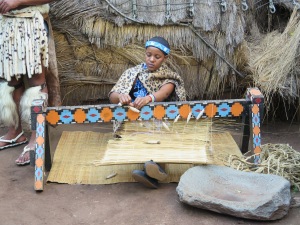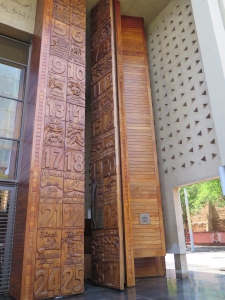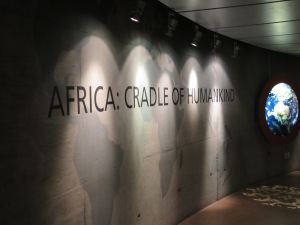South African Museums: If You Build It, Will They Come?
 Can a museum sustain itself financially if there are few visitors? It seems as though many of the museums and attractions that we have visited, including Constitution Hill, the Cradle of Humankind, Liliesleaf Farm, and Lesedi Cultural Village have had very few visitors while we were there. In fact, at some we were the only ones. At the attractions where there were others, from asking the visitors it seems as though they were almost all foreigners and tourists, not South Africans.
Can a museum sustain itself financially if there are few visitors? It seems as though many of the museums and attractions that we have visited, including Constitution Hill, the Cradle of Humankind, Liliesleaf Farm, and Lesedi Cultural Village have had very few visitors while we were there. In fact, at some we were the only ones. At the attractions where there were others, from asking the visitors it seems as though they were almost all foreigners and tourists, not South Africans.
While some museums and attractions are funded privately, many of the museums we visited are funded publicly. The question that this poses is, how can the South Africa Department of Tourism get not only more tourists to visit these places, but locals and keep it financial sensible? It is summer in South Africa and some schools are not in session, so there may not be many field trips with locals to these museums, however, that does not explain the lack of tourists, as it is South Africa’s busy season (South African Tourism, 2013). So how has the investment in the museums paid off, and how can they be financially sustainable?
Case Study: Maropeng, The Cradle of Humankind
 When we first arrived at Maropeng, there were few visitors there besides us and another school group. However, there were several employees including tour guides, gift shop workers, food workers, and other museum staff. The Cradle of Humankind has several locations, and in total, it turns out that there are 7,000 permanent and 2,200 “casual” employees (Maropeng, 2015). In addition to the payment of the employees, the Gauteng Provincial Government has “invested over R250 million in roads and bulk infrastructure in the two destinations in order to boost tourism development” (Maropeng, 2015). If each day was as busy as the day that we went, it seems as though the investment may not be paying off. Also, “In October 2003, the Gauteng Provincial Government entered into a contract valued at R163 million with Maropeng a’Afrika Leisure (Pty) Ltd for the construction, design and operation of world-class visitor exhibition and recreational facilities showcasing the site. This Public Private Partnership is the first of its kind, a concession agreement requiring Maropeng a’Afrika Leisure (Pty) Ltd to pay an annual concession fee which government will invest in community benefit projects and in scientific research” (Maropeng, 2015). While the scientific research is a benefit to the community and the world, the government may be spending too much money.
When we first arrived at Maropeng, there were few visitors there besides us and another school group. However, there were several employees including tour guides, gift shop workers, food workers, and other museum staff. The Cradle of Humankind has several locations, and in total, it turns out that there are 7,000 permanent and 2,200 “casual” employees (Maropeng, 2015). In addition to the payment of the employees, the Gauteng Provincial Government has “invested over R250 million in roads and bulk infrastructure in the two destinations in order to boost tourism development” (Maropeng, 2015). If each day was as busy as the day that we went, it seems as though the investment may not be paying off. Also, “In October 2003, the Gauteng Provincial Government entered into a contract valued at R163 million with Maropeng a’Afrika Leisure (Pty) Ltd for the construction, design and operation of world-class visitor exhibition and recreational facilities showcasing the site. This Public Private Partnership is the first of its kind, a concession agreement requiring Maropeng a’Afrika Leisure (Pty) Ltd to pay an annual concession fee which government will invest in community benefit projects and in scientific research” (Maropeng, 2015). While the scientific research is a benefit to the community and the world, the government may be spending too much money.
When the museum opened in 2005, it was expected to receive 500,000 annual visitors (News24, 2005). At an average cost of R100 (Maropeng, 2015), even with 500,000 visitors the museum would only be collecting R50 million annually. With a monthly minimum wage of R2,065 (Labour Department, 2014) for 7,000 employees, that is a total salary budget of more than R173 million. This means that either the employees are not being fairly compensated or the Gauteng Provincial Government is subsidizing the extra funds. This does not even factor in any museum operating expenses, and it’s at the 500,000 expected annual visitors. However, this also does not factor in any food or gift shop items sold. Still, there is a large disconnect between the money that is being taken in and the expenses of running a museum.
Final Thoughts
It is hard to say what the South African Department of Tourism and local governments should do about this problem, however it seems as though there is a large problem in the money being collected and spent. It is such a challenge for these organizations because these museums contain such important information and are grounds of research organizations; however, they cannot continue to operate without making money.
References:
(2005). Mbeki opens Maropeng centre. News24. Retrieved from http://www.news24.com/SciTech/News/Mbeki-opens-Maropeng-centre-20051207
Maropeng a’Afrika and the Cradle of Humankind. (2015). Retrieved from http://www.maropeng.co.za/content/page/about
South African Department of Labour. (2014). Correction Notice Domestic Worker 2014 [Data file]. Retrieved from http://www.labour.gov.za/DOL/downloads/legislation/sectoraldeterminations/basic-conditions-of- employment/Correction%20Notice%20Domestic%20worker%202014.pdf
South African Department of Tourism. (2013). Total Tourists [Data file]. Retrieved from http://www.southafrica.net/uploads/files/Tourists_Table_A_DEC2013_12052014_1.pdf
All photos taken by and are property of Zach Strohmeyer.
